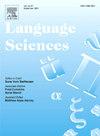从有机化合物的英文系统名称构建化学知识:系统功能语言学的视角
IF 1.1
2区 文学
Q2 EDUCATION & EDUCATIONAL RESEARCH
引用次数: 0
摘要
本文探讨了有机化合物英文系统名称如何解释化学知识。本研究借鉴系统功能语言学的结构类型和场域模型,分析了组织esnoc的语法结构以及这些结构所实现的特定场域意义。通过分析,揭示了支持esnoc意义建构的三种结构类型:(1)构成分类分类和构成分类的多元结构;(2)下邻基结构-单层和双层下邻基双相化合物-通过添加可测量的空间属性来补充多元结构,该属性指定了组合物分类中取代基或官能团的位置,并通过表示有机化合物中所需的尽可能多的相同取代基和/或官能团来扩展该分类的广度;(3)单变量结构,其中形合结构通过指定不同的分类分类深度来补充多元结构,对位结构通过扩展不同取代基的组成分类宽度和丰富空间性质来补充多元和次邻近结构。这些特定领域的含义构成了大多数esnoc的学科功能。关于组织esnoc的语法结构的发现揭示了有机化学中使用的这些专业术语如何实现其学科功能。本文章由计算机程序翻译,如有差异,请以英文原文为准。
Construing chemistry knowledge through English systematic names of organic compounds: a Systemic Functional Linguistics perspective
This paper explores how English systematic names of organic compounds (ESNOCs) construe chemistry knowledge. Drawing on types of structure and the field model in Systemic Functional Linguistics, this study analyzes the grammatical structures organizing ESNOCs and the field-specific meanings realized by these structures. The analysis reveals three types of structures underpinning the meaning-making of ESNOCs: (1) multivariate structures that construe a classification taxonomy and a composition taxonomy; (2) subjacency structures – one-layer and two-layer subjacency duplexes – that complement the multivariate structures by adding a gauged spatial property that specifies the locations of substituents or functional groups within the composition taxonomy and expanding the breadth of this taxonomy through the representation of as many identical substituents and/or functional groups as needed in an organic compound; (3) univariate structures, where the hypotactic ones complement the multivariate structures by specifying the different depths of the classification taxonomy, and the paratactic ones complement the multivariate and subjacency structures by expanding the composition taxonomy breadth for distinct substituents and enriching the sptial property, respectively. These field-specific meanings constitute the disciplinary affordance of most ESNOCs. The findings regarding the grammatical structures organizing ESNOCs reveal how these technical terms used in organic chemistry achieve their disciplinary affordances.
求助全文
通过发布文献求助,成功后即可免费获取论文全文。
去求助
来源期刊

Language Sciences
Multiple-
CiteScore
2.90
自引率
0.00%
发文量
38
期刊介绍:
Language Sciences is a forum for debate, conducted so as to be of interest to the widest possible audience, on conceptual and theoretical issues in the various branches of general linguistics. The journal is also concerned with bringing to linguists attention current thinking about language within disciplines other than linguistics itself; relevant contributions from anthropologists, philosophers, psychologists and sociologists, among others, will be warmly received. In addition, the Editor is particularly keen to encourage the submission of essays on topics in the history and philosophy of language studies, and review articles discussing the import of significant recent works on language and linguistics.
 求助内容:
求助内容: 应助结果提醒方式:
应助结果提醒方式:


